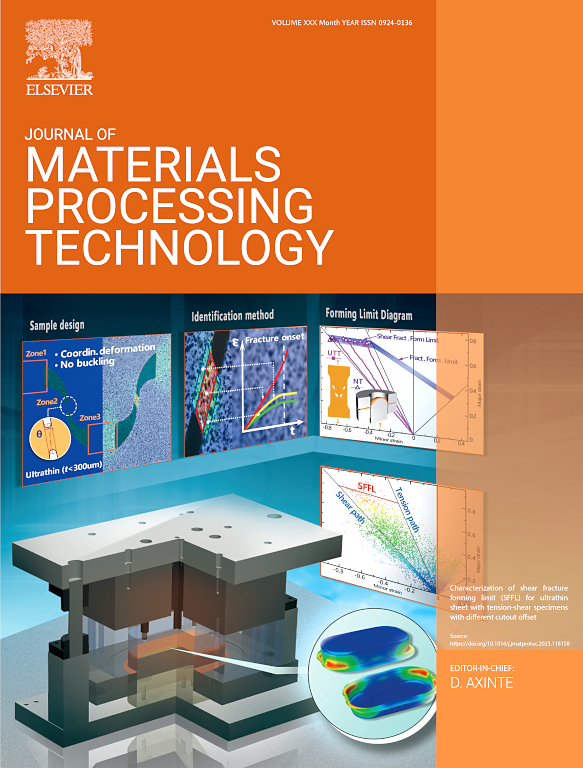Separation of aluminum and silicon from crystallizing Al–12.6wt%Si eutectic melts by applying an electromagnetic force during directional solidification
IF 6.7
2区 材料科学
Q1 ENGINEERING, INDUSTRIAL
Journal of Materials Processing Technology
Pub Date : 2025-05-31
DOI:10.1016/j.jmatprotec.2025.118916
引用次数: 0
Abstract
Fine eutectic phases grow in a coupled mode from a quiescent liquid pool with a eutectic composition under a usual casting condition. The Al–12.6mass%Si (hereafter Al–12.6 %Si for simplicity) alloy belongs to such a typical eutectic system that consists of fine Si plates/rods embedding in the Al matrix after solidification. Conventionally, it seems impossible to separate Al and Si from the eutectic alloy in directional solidification. Herein, we developed a novel process to separate Al and Si from the eutectic liquid when a directional electromagnetic force (EMF) was applied upon the crystallizing solid/liquid interface. Solidification structures were observed, confirming that Al and Si could be effectively separated from the eutectic melt during continuous casting. Fluid flow simulation results were applied to elucidate the separation behavior and growth directions of Al dendrites and Si crystals. The formation mechanism of the Al dendrites as the leading phase was clarified when considering the turbulent fluid flow upon the application of EMF. The influence of the casting speed and Lorentz force on the separation efficiency was examined, which plays a key role in scaling up the casting billet for application in industry. The aggregated Si crystals were characterized by the electron backscatter diffraction (EBSD) technique, showing convincing evidence of Si growth, which is of importance in modifying the casting setup. The successful separation of Al and Si from the eutectic alloy using the present technique can eventually amend the recycling chain of Al–Si based alloys; casting Al scraps can be upgraded to wrought Al-based materials and the separated Si blocks can be reused to produce photovoltaic cells. Finally, an ideal setup was proposed for the continuous casting of Al and Si metals simultaneously as they can be separated effectively, which may serve as a raw model in tackling with the tough challenge of the eutectic alloy recycling.
定向凝固过程中施加电磁力使铝和硅从Al-12.6wt %Si共晶熔体中分离
在普通铸造条件下,细共晶相以耦合方式从含有共晶成分的静止液池中生长出来。Al - 12.6mass%Si(简写为Al - 12.6 %Si)合金属于这样一种典型的共晶体系,它由凝固后嵌入Al基体中的细小Si板/棒组成。在定向凝固中,通常不可能将Al和Si从共晶合金中分离出来。在此,我们开发了一种新的工艺,当在结晶的固/液界面上施加定向电磁力(EMF)时,将Al和Si从共晶液体中分离出来。观察到凝固组织,证实了Al和Si在连铸过程中可以有效地从共晶熔体中分离出来。利用流体流动模拟结果分析了Al枝晶与Si晶的分离行为和生长方向。在考虑电磁场作用下湍流流动的情况下,阐明了Al枝晶作为先导相的形成机理。研究了铸造速度和洛伦兹力对分离效率的影响,这对扩大铸坯的工业应用具有关键作用。利用电子背散射衍射(EBSD)技术对Si晶体进行了表征,显示出Si生长的证据,这对改进铸造工艺具有重要意义。利用该技术成功地从共晶合金中分离出Al和Si,最终修正了Al - Si基合金的回收链;铸造铝废料可以升级为锻造铝基材料,分离的硅块可以重复使用来生产光伏电池。最后,提出了Al和Si金属同时连续铸造的理想装置,因为它们可以有效地分离,这可以为解决共晶合金回收的严峻挑战提供一个原始模型。
本文章由计算机程序翻译,如有差异,请以英文原文为准。
求助全文
约1分钟内获得全文
求助全文
来源期刊

Journal of Materials Processing Technology
工程技术-材料科学:综合
CiteScore
12.60
自引率
4.80%
发文量
403
审稿时长
29 days
期刊介绍:
The Journal of Materials Processing Technology covers the processing techniques used in manufacturing components from metals and other materials. The journal aims to publish full research papers of original, significant and rigorous work and so to contribute to increased production efficiency and improved component performance.
Areas of interest to the journal include:
• Casting, forming and machining
• Additive processing and joining technologies
• The evolution of material properties under the specific conditions met in manufacturing processes
• Surface engineering when it relates specifically to a manufacturing process
• Design and behavior of equipment and tools.
 求助内容:
求助内容: 应助结果提醒方式:
应助结果提醒方式:


